Museums Ambrosiana | Castello Sforzesco | Poldi Pezzoli
Castello Sforzesco Art Story | Location | Opening Hours Tickets | Authorizations
Art Story The Castle | Leonardo da Vinci | Frescoes | Ducal Chapel | Standard Milan | Bernabo Visconti | F. Rusca
Frescoes of the Castello Sforzesco Museum in Milan in Italy
The Frescoes in the Hall of the Columbines
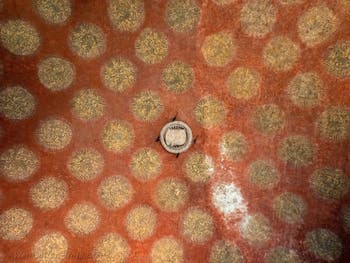
Frescoes in the Hall of the Columbines This room takes its name from the fresco painted on its roof representing doves presented against the background of radiant suns called “radia magna”.
The dove was the favourite bird of Bona of Savoy, the wife of Duke Galeazzo Maria Sforza.
The arch was, therefore, decorated accordingly with, in addition to the doves, the Visconti motto taken up by the Sforzas: “à bon droit”, meaning: "rightly" or "legitimately".
This motto, “à bon droit” was created by Francesco Petrarca, Petrarch, for Gian Galeazzo Visconti, who was then 17 years old when the Florentine poet and humanist was the guest of the Visconti.
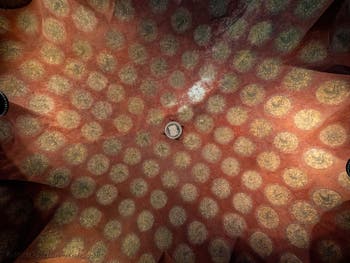
Frescoes in the Hall of the Columbines During his stay with the Visconti, Petrarch appreciated the moderation of the future Duke Gian Galeazzo Visconti, who augured for a future peaceful reign; hence, this motto was created for him.
Alas, Petrarch was wrong because Gian Galeazzo Visconti became Duke of Milan after having deposed his uncle Bernabo, who was indeed a tyrant.
Still, his ambitions for expansion were anything but peaceful.
His armies thus captured Pisa, Siena, and Perugia.
It was the plague that put an end to his ambitions by taking him to the grave in 1402 at the age of 51.
The Frescoes in the Hall of the Dukes or Sala dei Ducali
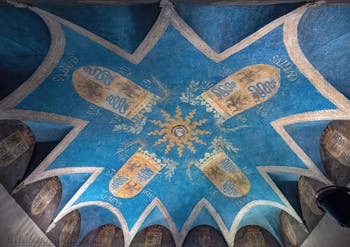
Hall of the Dukes or Ducali This room owes its name to the frescoes of the coats of arms of the Dukes of Milan that adorn its arch.
These frescoes were created at the request of Duke Galeazzo Maria Sforza in May 1469.
The coats of arms are painted on a beautiful azure blue background and are accompanied by the initials GM for Galeazzo Maria.
The initials LV were then added by Ludovico Maria Sforza, known as il Moro.
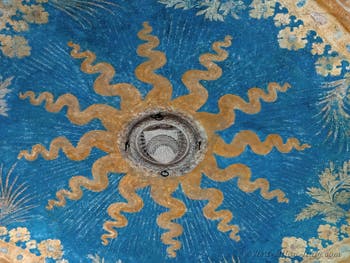
Hall of the Dukes or Ducali This coat of arms shows the imperial eagle associated with a blue viper crowned with gold that devours a red figure.
It is said that this emblem was attributed to Ottone Visconti (1207-1295) following his victories against the Saracens.
Another interpretation was given by Petrarch, who attributed it to Azzone Visconti (1302-1339) during a military campaign against the Bolognese.
Petrarch relates that the young Visconti got off his horse to rest and that, in the meantime, a viper had entered his helmet, which he placed next to him.
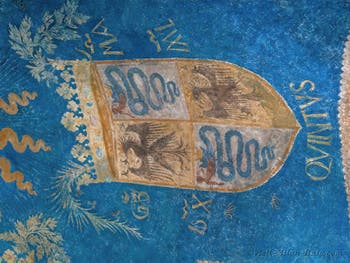
Hall of the Dukes or Ducali
When he put his helmet back on, the viper slipped up his cheek and fell to the ground without the young man showing any fear.
The young Azzone Visconti ordered that no one harm the viper and interpreted the fact that he had not been bitten as an omen of his next victory.
He would then have decided to use the viper as a military emblem, a viper that devours its enemies.
Frescoes in the San Donato Chapel in the Sforza Castle
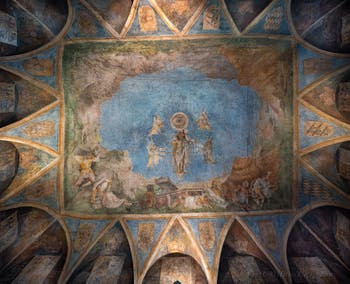
San Donato Chapel Frescoes In the lunettes of this San Donato chapel in the Sforzesco Castle are painted the weapons of the Sforza.
The initials of the Duke are also represented, while the Sforza heraldic motifs are reproduced on each arch pendant.
The chapel arch represents a scene of the resurrection of Christ, who rises triumphantly into the starry sky, abandoning his tomb.
On the ground lie the men who made her suffer.
Frescoes from the church of San Giovanni in Conca
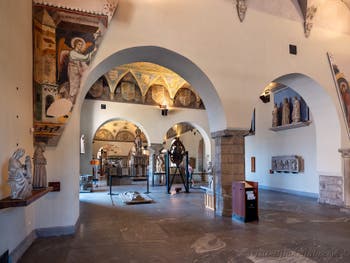
Frescoes San Giovanni in Conca The frescoes in the ceiling of room number two of the museum have preserved the decoration dating from the Spanish occupation.
They feature branches of flowers and fruits, while the heraldic motto of the Spanish governor Figheroa is in the centre.
On one of the walls of this same room, two lateral frescoes represent a scene from the Annunciation.
These frescoes were in the San Giovanni in Conca church in Milan before being integrated into the Sforza Castle Museum.
Art Story The Castle | Leonardo da Vinci | Frescoes | Ducal Chapel | Standard Milan | Bernabo Visconti | F. Rusca
Castello Sforzesco Art Story | Location | Opening Hours Tickets | Authorizations
Museums Ambrosiana | Castello Sforzesco | Poldi Pezzoli
Back to Top of Page









